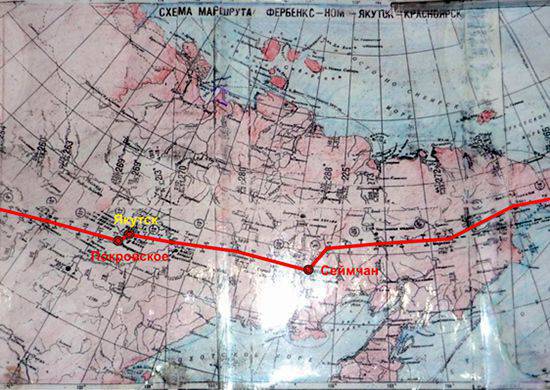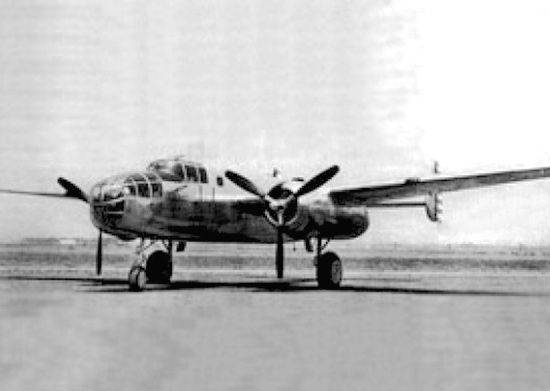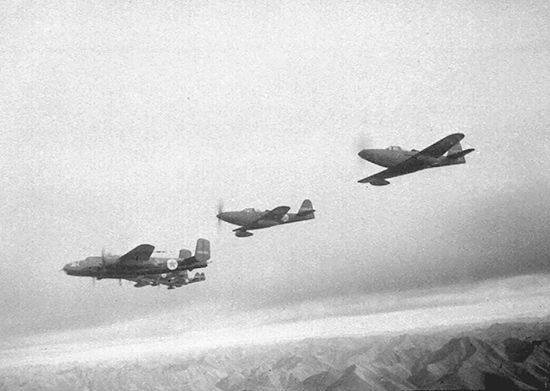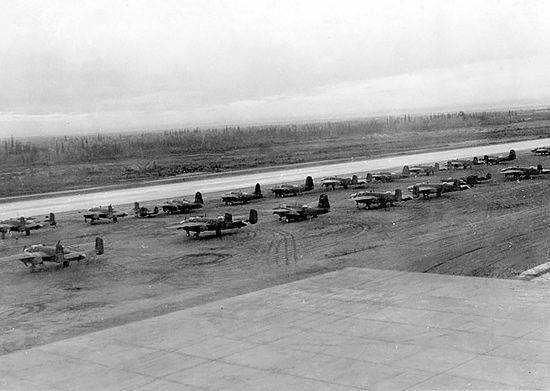Air convoys on the air route Alaska - Siberia

Long before the meeting on the Elbe, in the deep Siberian rear, the air line of the “second front” passing through the cold pole operated along which leased American leased-wing combat aircraft.
In the early days of World War II, the USSR lost 1200 combat aircraft. German dominated the sky aviation.
The first deliveries of American and British weapons, including aircraft, to the Soviet Union via the North Atlantic showed the unreliability of this route. The Germans, based in Northern Norway, drowned ships. At the beginning of 1942, 35 of the 17 ships of the caravan of allies of the PQ-23 were sunk 210. Together with them, 130 aircraft, XNUMX left tanks, 3350 cars and 100 thousand tons of cargo ...
And transportation along the southern route - across the Indian Ocean to the ports of Iran took more than two months.
US President Roosevelt wrote to Stalin: “If it were possible to make deliveries of aircraft from the United States to the Soviet Union through Alaska and Siberia, a large amount of time would be saved ...”
October 1 The First Moscow Protocol on the Supply of the USSR was signed in Moscow in 1941. The Lend-Lease Act was extended to the USSR 28 in October 1941, resulting in a loan to the Soviet Union for 1 billion dollars. During the war, three more protocols were signed: Washington, London and Ottawa, through which supplies were extended until the end of the war. Officially, Lend-Lease deliveries to the USSR stopped 12 in May 1945. However, until August 1945, deliveries continued according to the Molotov-Mikoyan list.
On instructions from the State Defense Committee of the USSR (GKO), specialists of the Civil Air Fleet, Air Force and Polar Aviation studied various options for the direction of the air route from Alaska. They chose a route through Chukotka, Kolyma and Yakutia to Krasnoyarsk. There were major junctions and relatively stable weather.
On October 9, 1941, GKO, by its decree No. 739c, entrusted the creation of this route to the General Directorate of Civil Air fleethanding it to the chief, Major General of Aviation V.S. Molokov’s mandate. October 13 was formed, and on the 16th already flew to Irkutsk the first group of specialists led by experienced builder D.E. Chusov. He was appointed construction manager of the Krasnoyarsk airway.
In November 1941, the reconstruction of existing airfields began. In Krasnoyarsk, two concrete runways were extended, taxiways were made, aircraft parkings were equipped. The airfield in Yakutsk was reconstructed. The construction of new airfields began in 1942 year. Along the route (fig.1) communication nodes, radio navigation, meteorological stations were built, flight maps were refined.
By the Decree of the State Defense Committee No. 1657 of April 26 of 1942 of the year and the order of the People's Commissar of Defense No. 126 of April of 27, the Civil Air Fleet (GVF) was subordinated to the commander of the Air Force of the Red Army, and V.S. Molokov ex officio became his deputy.
In July, the 1942 of the year, along the highway under construction, flew on the American B-25 bomber. Hero of the Soviet Union Vladimir Kokkinaki. He delivered to Moscow an American government commission to coordinate issues on the beginning of the distilling of the aircraft. Along the way, the readiness of aerodromes and equipment was checked. At the same time, authorized by the State Defense Committee, Major-General VS Molokov in a detailed note to the government and personally I.V. Stalin reported that the track was basically ready, in the fall you can begin the distillation.
V.S. Molokov On July 20, 1942, the State Defense Committee adopted Decree No. 2070 on the completion of the construction of the route and the start of the ferrying of aircraft. On July 23, the commission of the Main Directorate of the Civil Air Fleet for the inspection and acceptance of airfields, headed by engineer-captain A. Yanovsky, flew to the track. She returned to Moscow on November 7, having flown 200 hours along the route and along the way transporting 48,5 tons of construction cargo, radio equipment and 309 workers and employees of the route.
The report of the commission says that by the beginning of October 1942 of the year 10 airfields were introduced: previously operating Krasnoyarsk and Yakutsk and 8 new ones. Basic - Kirensk, Seymchan and Uelkal, intermediate and spare - Aldan, Olekminsk, Oymyakon, Berelekh and Markovo. Spare airfields with unpaved runways are also being built - Bodaibo, Vitim, Ust-May, Khandyga, Zyryanka, Anadyr. Some of them are only winter action. The conclusion of the commission: the airfields can be considered accepted for temporary operation.
In early August 1942 in the city of Ivanovo at the airbase 6-th spare aviation brigade began forming 1-th Ferry Air Division GVF, management and divisions of Krasnoyarsk airway (by order of the GKO number 2070s from 20 July 1942 years and Directive Deputy People's Commissar of Defense of 3 of August) . Colonel I.P. was appointed head of the highway and division commander. Mazuruk, a famous polar pilot, Hero of the Soviet Union. The division consisted of five air regiments. In the autumn, the crew was transported to the track. The headquarters of the division and the management of the airway were located in Yakutsk.
I.P. Mazuruk The place where the Soviet pilots took over the baton for the transfer of aircraft from their American colleagues was in the city of Fairbanks. Here, Soviet specialists carried out the acceptance of aircraft, and then they were already distilled by pilots from the USSR. Fairbanks, located in the center of Alaska, was chosen as the transfer site for aircraft due to its better security compared to Nome in the event of an attack by the Japanese, who occupied part of the state of Alaska in the summer of 1942.
October 7 1942, the first group of seven Kittyhawk P-40 fighters, piloted by the pilots of the 1 regiment, flew from Fairbanks to Uelkal. At the first stage, it was led by B-25 bomber (Figure 4), Colonel I.P. Mazuruk. For various reasons, the way to Krasnoyarsk took 33 day. 16 November 1942 of the year in Krasnoyarsk landed the first group of American aircraft overtaken from Alaska. During this long flight, two planes were lost, the crew of the 1 regiment was killed: the pilot, captain A.D. Novgorod and navigator captain N.A. Swedes. Simultaneously with the distillation was the development of American aircraft and tracks.

The first difficulty our pilots encountered was that all instructions, manuals and instructions, as well as the inscriptions on the dashboard of the aircraft were in English. Devices showed miles, feet and gallons. It was necessary to stick over the translations next to the English plate above each toggle switch and the device. On graphs, we have drawn transfer tables and pasted on the dashboard. Later, being used to it, they automatically converted miles to kilometers, feet to meters, gallons to liters.
The pilots had to thoroughly master the radio equipment, which they had not previously been taught. It was necessary to re-work the technique of take-off and landing: all domestic aircraft had two main wheels and a supporting tail, the American had a third wheel front.
On AlSib, bombers and transport planes were ferried one at a time, or in groups of two or three, the fighters flew in groups led by the leaders of the bombers. From Krasnoyarsk, the bombers drove to the front under their own power, and the fighters - disassembled by rail.

10 January 1943, the 1 th ferry regiment, which operated from Fairbanks to Uelkal, was placed under the military command of the Alaska Air Force. In June of the same year, the Moscow-Uelkal Airway Directorate was formed under the command of Major-General Alexander Alexandrovich Avseevich, also appointed Deputy Head of the Main Directorate of the Civil Air Fleet. I.P. Mazuruk remained the division commander. Krasnoyarsk airway became known as the Krasnoyarsk - Uelkal airway. It was led by Major General I.S. Semyonov. Accordingly, the route and 1-I ferry division subordinated to the management of the air route Moscow - Uelkal. August 23 The Civil Air Fleet 1943 was subordinated to the Commander of the Long-Range Aviation (ADD) Air Force under the command of the Air Force KA. 5 June 1944 of the year, as division commander I.P. Mazuruka was replaced by Colonel A.G. Melnikov, and October 1 place I.S. Semenov was taken by Hero of the Soviet Union, Lieutenant-General M.I. Shevelev.
In July, 1943, the head of the route, signed an order on the formation of management of 1 class airports (Kirensk, Yakutsk, Seymchan, Uelkal). Statewide, they were supposed to have two cars, six trucks, a special 12 and four tractors; personnel - 100 military personnel and 127 civilian. In August, the Krasnoyarsk 1 class airport, which was under the authority of the Air Force, was transferred to the highway in August. The airport housed the Kharkov Military Aviation School. In the workshops of the school the aircraft was repaired, repainted, prepared for shipment to the front. Also, the aircraft was repaired and prepared in workshops on the island of Molokov, on the territory of the ship repair plant, in the aircraft repair plant.
In the autumn of 1943, five airfields were commissioned: Nizhneilimsk, Vitim, Warm Key (Khandyga), Omolon (Kegali) and Anadyr. In Kirensk, Yakutsk and Seymchane runways covered with tar, some airfields were covered with prefabricated metal sheets delivered from the United States. In 1944, the airfields of Tanyurer and Chaplin in Chukotka were opened, as well as Uchur and Ekimchan - on the Yakutsk - Khabarovsk highway. In the same year, the radio equipment of the route was improved: 25 transmitters purchased in the USA, five receiving radio centers, 11 radio direction finders and two powerful radio stations in Yakutsk and Seymchan were installed. The material support of the route took place through the ports in Magadan, Tiksi, Provideniya, Ambarchik and Uelkale. From where, along the rivers and roads, cargo was transported to 25 reception points. In 1945, there were five main routes on the track. The main one is from Krasnoyarsk to Uelkal, as well as: Yakutsk - Khabarovsk, Anadyr - Magadan - Khabarovsk, Magadan - Kirensk - Krasnoyarsk and Yakutsk - Tiksi. Used up to thirty airfields.
In the summer of 1945, planes for the Trans-Baikal, First and Second Far Eastern Fronts and the Pacific Fleet were distilled along the route to support the war against the Japanese Empire. In August, deliveries of aircraft from the United States stopped on the highway, and the 1 th ferry regiment moved from Fairbanks to Markovo. Discontinued Aviation Division was disbanded in October 1945.
Ferry regiments. American pilots delivered planes to the city of Fairbanks in Alaska. In Fairbanks, the Soviet military mission took planes (Fig.6). In the US, the plane was overtaken from the starting point to the final destination by the same pilot, in contrast to the USSR, where the planes were transmitted by relay. The route from Fairbanks to Krasnoyarsk was divided into five stages. Five ferry aircraft regiments (PAP) of the first civil air division of the Civil Air Fleet were created.
The 1 Distillery Aviation Regiment drove the aircraft from Fairbanks through the Bering Strait to Uelkal. 2-th PAP was based in Uelkale and drove the aircraft to Seymchan. 3-th PAP - from Seymchan to Yakutsk, 4-th PAP - from Yakutsk to Kirensk, 5-th PAP - from Kirensk to Krasnoyarsk. Having transferred the planes to the neighboring regiment, the pilots returned to their base by transport planes of a special squadron, which was later transformed into the 8-th transport regiment. Not for long existed on the highway 7-th PAP, in which the pilots overtook the aircraft from the beginning to the end of the route, following the example of the Americans. As a result, this method was considered unsuccessful, and the regiment disbanded. 279 flight accidents occurred on the Soviet part of the route, of which: 39 crashes, 49 crashes, 131 crashes and 60 forced landings. Killed 114 people. The largest was the 17 incident of November 1942 of the year at the Krasnoyarsk airport Li-2 disaster of the 5 th distillation regiment, in which 30 died (according to other sources - 20 people).
Causes of losses: adverse weather conditions, poor meteorological support, design flaws and manufacturing defects (for this reason, 8 machines were lost), incomplete preparation for the departure of materiel (7 machines lost), poor piloting techniques in adverse weather conditions (18 aircraft lost), non-discipline flight composition (lost 8 aircraft), poor organization of flights (lost 9 aircraft).

Quantitative indicators of the track. The total length of the route from Fairbanks to Krasnoyarsk was 6500 km, of which, across the territory of the USSR, 5000 km. From the factory in the United States to the front in the USSR, the plane had to travel up to 14 000 km.
According to the division's report, 7908 single-engine and twin-engine aircraft were delivered along the AlSib route. Bombers: B-25 - 729 units, B-20 - 1355. Fighters: P-40 - 47, P-39 - 2616, P-63 - 2396, P-47 - 3 pieces. Transport C-47 - 707, C-46 - 1 and 54 training AT-6.
On the highway, not only drove the aircraft, but also transported various cargoes: military equipment, gold, mica (506 tons), food, equipment for hospitals, household and office supplies, mail (including 187 tons of pouch mail), and hatching eggs , dentures, needles for sewing machines, spare parts for watches and more.
Diplomats and military specialists moved along the AlSib route. The ambassadors of the USSR in the USA M.M. Litvinov and A.A. Gromyko, American generals, and in 1944, US Vice President Henry Wallace.
During its existence - from October 1942 to October 1945 of the year, 128371 passengers were transported by air route, of which 17322 are paid, 18753 tons of cargo, including 9125 tons of paid and 319 tons of mail.
Information